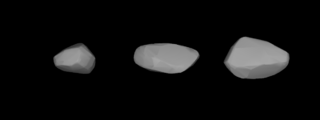Related Research Articles

Vincentina is a fairly large main belt asteroid.

Augusta is a main-belt asteroid, discovered on 31 March 1886 by astronomer Johann Palisa at Vienna Observatory, Austria. The stony S-type asteroid measures about 12 kilometers in diameter. It is the first-numbered member of the Augusta family, after which the small Asteroid family and subgroup of the main-belt has been named. Augusta was named after the German–Austrian writer Auguste von Littrow (1819–1890), widow of astronomer Carl Ludwig von Littrow, who was a former director of the Vienna Observatory.

Prymno is a somewhat large Main belt asteroid. It is classified as a B-type asteroid and probably has a primitive composition not unlike common C-type carbonaceous asteroids.

Dresda is a typical Main belt asteroid. It belongs to the Koronis family of asteroids.

Anna is a typical Main belt asteroid.

Tirza is a fairly sizeable, very dark Main belt asteroid.
2002 AT4 is a near-Earth object and potentially hazardous asteroid of the Amor group, approximately 350 meters (1,100 feet) in diameter. It has an eccentric orbit that brings it sometimes close to Earth's orbit, and sometimes halfway between Mars and Jupiter. It is a dark D-type asteroid which means that it may be reddish in color.
464 Megaira is a dark and large background asteroid, approximately 77 kilometers in diameter, located in the central region of the asteroid belt. It was discovered by astronomer Max Wolf at the Heidelberg Observatory in southwest Germany on 9 January 1901. The carbonaceous C-type asteroid (FX) has a rotation period of 12.9 hours. It was named after Megaera from Greek mythology.
Caprera is a minor planet orbiting the Sun.
Virtus is an 86 km minor planet orbiting the Sun. It was discovered by Max Wolf on October 7, 1902. Its provisional name was 1902 JV.

Sigune is a minor planet, specifically an asteroid orbiting primarily in the asteroid belt. Like 501 Urhixidur and 500 Selinur, it is named after a character in Friedrich Theodor Vischer's then-bestseller satirical novel Auch Einer.
Laodica is a minor planet orbiting the Sun.

Nassovia is a minor planet orbiting the Sun. It is a member of the Koronis family of asteroids.
625 Xenia is a minor planet orbiting the Sun. It was discovered by August Kopff in Heidelberg, Germany, on 11 February 1907. The name may have been inspired by the asteroid's provisional designation 1907 XN.
633 Zelima is a minor planet orbiting the Sun in the asteroid belt with a magnitude of 10.7. The name may have been inspired by the asteroid's provisional designation 1907 ZM.
635 Vundtia is a minor planet orbiting the Sun - though this claim has been disputed.
663 Gerlinde is a minor planet orbiting the Sun.
768 Struveana is a minor planet orbiting the Sun. The asteroid was named jointly in honor of Baltic German astronomers Friedrich Georg Wilhelm von Struve, Otto Wilhelm von Struve and Karl Hermann Struve.
6144 Kondojiro (1994 EQ3) is an asteroid discovered on March 14, 1994 by Kin Endate and Kazuro Watanabe at the Kitami Observatory in eastern Hokkaidō, Japan. It is named after Jiro Kondo, a Japanese Egyptologist and professor of archaeology at Waseda University.
2021 LL37 is a large trans-Neptunian object in the scattered disc, around 600 kilometres (370 miles) in diameter. It was discovered on 12 June 2021, by American astronomers Scott Sheppard and Chad Trujillo using Cerro Tololo Inter-American Observatory's Dark Energy Camera in Chile, and announced on 31 May 2022. It was 73.9 astronomical units from the Sun when it was discovered, making it one of the most distant known Solar System objects from the Sun as of May 2022. It has been identified in precovery images from as far back as 28 April 2014.
References
- 1 2 "491 Carina (1902 JQ)". JPL Small-Body Database . NASA/Jet Propulsion Laboratory . Retrieved 9 May 2016.
- 1 2 3 Fienga, A.; Avdellidou, C.; Hanuš, J. (February 2020). "Asteroid masses obtained with INPOP planetary ephemerides". Monthly Notices of the Royal Astronomical Society. 492 (1): 589–602. doi: 10.1093/mnras/stz3407 .